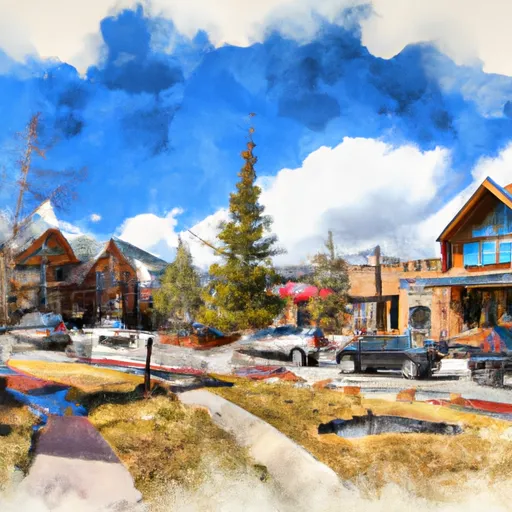-
 Snoflo Premium
Snoflo Premium
Get unlimited access to all our content
With no Ad interruptions! - Start Your Free Trial Login with existing account
Breckenridge
Eden Index
Climate
5.6
•
Recreation
9.4
•
Community
3.4
•
Safeguard
6.4/10

Breckenridge is a picturesque mountain town located in Summit County, Colorado. The climate is alpine, with cold winters and mild summers. The hydrology constituents include the Blue River, which flows through the town and provides a source of recreation for fishing, kayaking, and rafting. Breckenridge is known for its world-class ski resort, which is open from late November to early April and offers skiing, snowboarding, and snowshoeing. In the summer, visitors can enjoy hiking, mountain biking, and golfing at one of the three golf courses. Other popular outdoor activities include fly fishing, horseback riding, and hot air balloon rides. With its stunning mountain scenery and year-round recreational opportunities, Breckenridge is a must-visit destination for outdoor enthusiasts.
What is the Eden Index?
The Snoflo Eden Index serves as a comprehensive rating system for regions, evaluating their desirability through a holistic assessment of climate health, outdoor recreation opportunities, and natural disaster risk, acknowledging the profound impact of these factors on livability and well-being.
Climate Health Indicator (CHI): 5.6
Breckenridge receives approximately
596mm of rain per year,
with humidity levels near 56%
and air temperatures averaging around
2°C.
Breckenridge has a plant hardyness factor of
4, meaning
plants and agriculture in this region thrive during a short period during spring and early summer. Most
plants will die off during the colder winter months.
By considering the ideal temperature range, reliable water supplies, clean air, and stable seasonal rain or snowpacks, the Climate Health Indicator (CHI) underscores the significance of a healthy climate as the foundation for quality living.
A healthy climate is paramount for ensuring a high quality of life and livability in a region, fostering both physical well-being and environmental harmony. This can be characterized by ideal temperatures, reliable access to water supplies, clean air, and consistent seasonal rain or snowpacks.
Weather Forecast
Streamflow Conditions
Colorado Headwaters
Area Rivers
Colorado Headwaters
Snowpack Depths
Colorado Headwaters
Reservoir Storage Capacity
Colorado Headwaters
Groundwater Levels
Recreational Opportunity Index (ROI): 9.4
The Recreational Opportunity Index (ROI) recognizes the value of outdoor recreational options, such as parks, hiking trails, camping sites, and fishing spots, while acknowledging that climate plays a pivotal role in ensuring the comfort and consistency of these experiences.
Access to outdoor recreational opportunities, encompassing activities such as parks, hiking, camping, and fishing, is crucial for overall well-being, and the climate plays a pivotal role in enabling and enhancing these experiences, ensuring that individuals can engage in nature-based activities comfortably and consistently.
Camping Areas
| Campground | Campsites | Reservations | Toilets | Showers | Elevation |
|---|---|---|---|---|---|
| Kite Lake | 5 | 12,043 ft | |||
| Horseshoe | 19 | 10,538 ft | |||
| Weston Pass | 14 | 10,277 ft | |||
| Mount Princeton | 19 | 8,618 ft | |||
| Railroad Bridge - Arkansas Headwaters State Rec Area | None | 8,039 ft | |||
| Ruby Mountain - Arkansas Headwaters State Rec Area | None | 7,651 ft | |||
| Chalk Lake | 19 | 8,743 ft | |||
| Cascade | 22 | 9,033 ft | |||
| Fourmile | 14 | 10,824 ft | |||
| Buffalo Springs | 18 | 9,187 ft |
Nearby Ski Areas
Catastrophe Safeguard Index (CSI):
The Catastrophe Safeguard Index (CSI) recognizes that natural disaster risk, encompassing floods, fires, hurricanes, and tornadoes, can drastically affect safety and the overall appeal of an area.
The level of natural disaster risk in a region significantly affects safety and the overall livability, with climate change amplifying these risks by potentially increasing the frequency and intensity of events like floods, fires, hurricanes, and tornadoes, thereby posing substantial challenges to community resilience and well-being.
Community Resilience Indicator (CRI): 3.4
The Community Resilience Indicator (CRI) recognizes that education, healthcare, and socioeconomics are crucial to the well-being of a region. The CRI acknowledges the profound impact of these elements on residents' overall quality of life. By evaluating educational resources, healthcare accessibility, and economic inclusivity, the index captures the essential aspects that contribute to a thriving community, fostering resident satisfaction, equity, and social cohesion.

